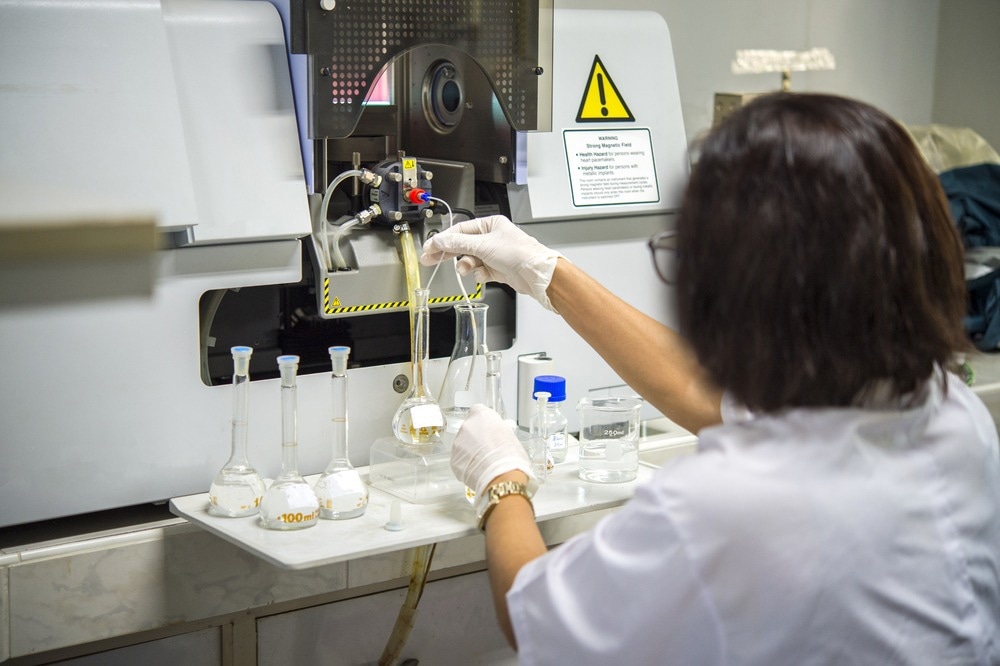In a recent study published in the journal Molecules, researchers compared the potential of vibrational spectroscopic approaches for monitoring water content in natural deep eutectic solvents (NADES).

Study: Comparison of Vibrational Spectroscopic Techniques for Quantification of Water in Natural Deep Eutectic Solvents. Image Credit: Rabbitmindphoto/Shutterstock.com
Raman spectroscopy (RS), attenuated total reflectance infrared (ATR-IR), and near-infrared spectroscopy (NIRS) were examined as label-free water quantification techniques in this study. The results are promising for the future development of green technologies that monitor and optimize NADES-based operations in an industrial environment.
Significance of NADES in the Chemical Industry
The chemical industry seeks to mitigate the negative environmental effect of chemical wastes with bio-renewable and biodegradable materials. Natural deep eutectic solvents (NADES) show significant potential in this area as an alternative to toxic chemical solvents.
They outperform conventional solvents in extraction rates and efficacy because of their ease of preparation, cost-effectiveness and flexibility. NADES are being researched for various reported applications such as biotechnology, analytical chemistry, nanotechnology, electrochemistry, water remediation, food, and pharmaceutics industries.
The viscous property of NADES is a significant obstacle in analytical chemistry applications. However, regulated water addition reduces viscosity and enhances solvation and mass transfer processes.
Depending on the kind of solutes, a change in water concentration affects the polarity and solubilization capacity of NADES. The water molar ratio in NADES is essential for enzyme reactions.
However, increasing water content may decrease the interactions between NADES and the target molecules. Consequently, measuring water content is necessary to assure the stability of experiments.
Water Quantification Techniques
Karl Fisher (KF) titration
The most accurate method for measuring water content is KF titration. However, despite the high sensitivity, the technique requires vast amounts of solvent and reagent for titration and takes significant time to analyze large sample cohorts.
Gravimetric method
The gravimetric method is a simple, cost-effective, and solvent-free technique for measuring the sample's weight loss due to water evaporation. However, results are inconsistent owing to heat degradation of the sample or volatile substances.
Vibrational spectroscopy
Vibrational spectroscopy, i.e., handheld near-infrared spectroscopy (NIR‐H), benchtop near-infrared spectroscopy (NIR‐B) and Raman spectroscopy (RS), includes non‐invasive, non‐destructive, label‐free, cost‐effective and reagent‐free spectroscopic techniques that rapidly examine samples' chemical compositions with little or no preparation.
The water content of NADES is often more than 1% w/w. Therefore, the high sensitivity of the Karl fisher titration approach is not required.
Using Vibrational Spectroscopic Techniques to Monitor Water Content in NADES
Elderderi et al. designed the NADES model with the hydrogen bond donor Levulinic Acid and the hydrogen bond acceptor L-Proline.
A Frontier Fourier transform infrared spectrometer, multipurpose Fourier-transform near-infrared spectrophotometer, near-infrared (NIR) transmission spectrometer, and Labram spectrometer were used to collect spectrum from ATR‐IR, NIR‐B, NIR‐H and Raman‐B techniques, respectively.
The acquired data from ATR-IR, NIR-B, and NIR-H was analyzed in MATLAB without pre-processing.
Rubberband (RB) correction helped estimate a piecewise polynomial baseline to reduce variability owing to any baseline in the spectra.
The data was subjected to partial least squares regression (PLSR) to develop a linear model between spectral variations and the systematically varying water concentrations.
The statistical relevance of the quantitative analysis was validated using cross-validation techniques with a three-way division of the data into validation, calibration, and test sets.
Significant Findings of the Study
Elderderi et al. assessed the relative performance of Raman, NIR, and ATR-IR spectroscopy in combination with PLSR analysis to monitor water in Levulinic Acid/L‐Proline (LALP) NADES.
Attenuated total reflection infrared spectroscopy (ATR-IR) was the most accurate method for determining the proportion of water added to LALP NADES.
The PLSR analysis regression coefficient highlights the contribution of NADES chemicals and water, increasing the prediction models' dependability. Although the process requires sample extraction and deposition on an ATR crystal, it is a feasible way to provide more ecologically friendly reagent-free water measurement in NADES.
NIR-H, NIR-B, and Raman-B were less accurate than ATR-IR, but the findings demonstrated that these methods are effective for label-free water quantification in LALP NADES.
The Future of Vibrational Spectroscopic Techniques
While KF titration continues to be the industry standard for determining the moisture content of materials, greener options are now available to help the transition toward more ecologically friendly practices.
The experimental findings provide an opportunity to create tools that can monitor and improve NADES-based processes while practically applicable in the industries.
Reference
Elderderi, S., Sacré, P-Y., Wils, L., Chourpa, I., Elbashir, A.A., Hubert, P., Byrne, H.J., Boudesocque-Delaye, L., Ziemons, E., & Bonnier, F. (2022). Comparison of Vibrational Spectroscopic Techniques for Quantification of Water in Natural Deep Eutectic Solvents. Molecules. 2022; 27(15):4819. https://www.mdpi.com/1420-3049/27/15/4819
Disclaimer: The views expressed here are those of the author expressed in their private capacity and do not necessarily represent the views of AZoM.com Limited T/A AZoNetwork the owner and operator of this website. This disclaimer forms part of the Terms and conditions of use of this website.